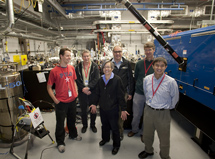
Handy Links
SLAC News Center
SLAC Today
- Subscribe
- Archives: Feb 2006-May 20, 2011
- Archives: May 23, 2011 and later
- Submit Feedback or Story Ideas
- About SLAC Today
SLAC News
Lab News
- Interactions
- Lightsources.org
- ILC NewsLine
- Int'l Science Grid This Week
- Fermilab Today
- Berkeley Lab News
- @brookhaven TODAY
- DOE Pulse
- CERN Courier
- DESY inForm
- US / LHC
SLAC Links
- Emergency
- Safety
- Policy Repository
- Site Entry Form

- Site Maps
- M & O Review
- Computing Status & Calendar
- SLAC Colloquium
- SLACspeak
- SLACspace
- SLAC Logo
- Café Menu
- Flea Market
- Web E-mail
- Marguerite Shuttle
- Discount Commuter Passes
-
Award Reporting Form
- SPIRES
- SciDoc
- Activity Groups
- Library
Stanford
Around the Bay
LCLS Launches User Science Today
SLAC's Linac Coherent Light Source opened for business this morning, and the first user experiment is now underway. As the world's first hard X-ray laser, the LCLS offers scientists the ability to study the fundamental behavior of atoms and molecules on unprecedented length- and time scales.
"The LCLS is performing beyond our expectations," said newly appointed LCLS Deputy Director Uwe Bergmann. "These first experiments are starting a new era of science, one that many researchers around the world have eagerly awaited."
This first user run will continue through mid-December, with 11 groups traveling to SLAC to use the Atomic, Molecular and Optical science instrument—the first of the six LCLS instruments to come online.
This week's experiment, led by Argonne National Laboratory's Linda Young, will provide a better understanding of how materials absorb very high intensity X-rays, by stripping atoms of their electrons from the inside out.
"It's exciting to be here," said Young, who is writing about her experience online. "The LCLS instrument scientists and their team have done so much work to get to this point. I'm very optimistic for our experiment."
SLAC AMO instrument scientists John Bozek and Christoph Bostedt worked 12-hour shifts around the clock for the past months as they and their hardworking team—which includes engineers, physicists, controls experts, technicians and many others—tuned or "commissioned" the instrument. Bozek and Bostedt will now work in collaboration with Young and her team on this week's experiment.
"This is a significant milestone for LCLS, made possible by the hard work of many people. I am grateful and delighted that the entire lab pulled together to get us to the point where we can welcome our first users. Some users have helped during commissioning, and they can now call the shots," said LCLS Director Jo Stöhr. "This is also a good time to acknowledge the Department of Energy for their unwavering support. Let the science begin!"
Funded by the DOE Office of Science, the LCLS is a collaboration among several DOE National Laboratories, including SLAC National Accelerator Laboratory and Argonne, Lawrence Berkeley and Lawrence Livermore National Laboratories; Cornell University and the University of California, Los Angeles. Pacific Northwest National Laboratory provided additional project management which helped make this project successful.
—Kelen Tuttle
SLAC Today, October 1, 2009
